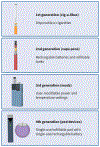The paradox of the safer cigarette: understanding the pulmonary effects of electronic cigarettes
- PMID: 38609098
- PMCID: PMC12077657
- DOI: 10.1183/13993003.01494-2023
The paradox of the safer cigarette: understanding the pulmonary effects of electronic cigarettes
Abstract
Electronic cigarette (e-cigarette) use continues to rise globally. E-cigarettes have been presented as safer alternatives to combustion cigarettes that can mitigate the harm associated with tobacco products; however, the degree to which e-cigarette use itself can lead to morbidity and mortality is not fully defined. Herein we describe how e-cigarettes function; discuss the current knowledge of the effects of e-cigarette aerosol on lung cell cytotoxicity, inflammation, antipathogen immune response, mucociliary clearance, oxidative stress, DNA damage, carcinogenesis, matrix remodelling and airway hyperresponsiveness; and summarise the impact on lung diseases, including COPD, respiratory infection, lung cancer and asthma. We highlight how the inclusion of nicotine or flavouring compounds in e-liquids can impact lung toxicity. Finally, we consider the paradox of the safer cigarette: the toxicities of e-cigarettes that can mitigate their potential to serve as a harm reduction tool in the fight against traditional cigarettes, and we summarise the research needed in this underinvestigated area.
Copyright ©The authors 2024. For reproduction rights and permissions contact permissions@ersnet.org.
Conflict of interest statement
Conflict of interest: K. Allbright reports grants from Burroughs Wellcome Fund and T32 (5T32HL007563-35), outside the submitted work. L.E. Crotty Alexander reports grants from NIH NHLBI R01, NIH NHLBI K24 and VA Merit Award, advisory board participation with Regeneron, and leadership roles with CHEST and ALA San Diego, outside the submitted work. M. Zhang reports support for the present article from Regeneron Pharmaceuticals. K.H. Benam has received grants from the US Food and Drug Administration, US National Institutes of Health, US Department of Defense and the Gordon and Betty Moore Foundation, royalties from Emulate Inc., consulting fees from Pneumax LLC, has received invited speaker honorarium from Colorado State University, has multiple pending and issued patent applications, has non-significant personal investments in a number of publicly traded companies, and is the founder of Pneumax LLC. The remaining authors have no potential conflicts of interest to disclose.
Figures





References
-
- Centers for Disease Control and Prevention. E-cigarette, or Vaping, Products Visual Dictionary. 2018. https://www.cdc.gov/tobacco/basic_information/e-cigarettes/pdfs/ecigaret....
-
- National Academies of Sciences, Engineering, and Medicine, Health and Medicine Division; Board on Population Health and Public Health Practice, Committee on the Review of the Health Effects of Electronic Nicotine Delivery Systems. Public Health Consequences of E-Cigarettes. Eaton DL, Kwan LY, Stratton K, Eds. Washington, National Academies Press, 2018. - PubMed
Publication types
MeSH terms
Substances
Grants and funding
LinkOut - more resources
Full Text Sources
Medical
